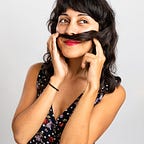Experimentation as a tool for innovative and differential product creation
How can we challenge our design processes to encourage the freedom to explore and express with confidence, and ultimately create original and memorable experiences?
Today we are swimming in a sea of homogeneity — where the speed to market is valued over beauty in the detail. But where does this leave us as we compete in a world of sameness? Do the people we serve, in the products and services we create, feel considered and cared for in our expression of ideas? And can innovation really happen, when creativity is stifled and de-prioritised in an effort to streamline and iterate fast?
We believe that experimentation should be at the core of our process. A mindset. A philosophy. A culture.
Experimentation is by definition the action or process of trying out new ideas, methods, or activities. We can also consider this a state of mind — open, curious, provocative, tenacious. In our design process, it requires the ability to overcome failure. Try, fail, learn. Try, fail, learn. Until we succeed, or gracefully wave a white flag, pivoting to the new.
Design without intention
We are conditioned by the examples around us, as well as our accrued work experience evolved through the pressures of deadlines and speed-orientated methodologies, to sit in front of a screen for hours on end, waiting for beauty to materialise. What we struggle with is having the confidence, or knowledge of, how to break these habits.
James Webb Young describes in his book “A Technique for Producing Ideas”, the five critical steps to produce a new idea. We believe that it is possible to apply this process in within today’s design world as we seek to incorporate greater experimental thinking that leads to unintended, yet magical, results.
- Gather new material — collect both specific, relating to the product/service and user, and raw materials, relating to life and events. Make browsing and information-gathering habitual.
- Digest materials—mentally chew the information you have gathered. Like you would a puzzle, look at the material from different angles and experiment as you synthesise ideas together for new relationships and meaning.
- Unconscious processing—simply drop it. Go and do something unrelated that stimulates creativity or your emotions. Let your subconscious do the rest.
- A-ha!—you made it to the fourth step. Your idea will come to you, perhaps unexpectedly such as in the shower, in a supermarket, doing laundry — usually once you have stopped forcing it.
- Shape and adapt—take your idea out into the world. Test with real people and seek the critique of others to refine your idea into something useful and original.
We have infinite possibilities in our methods of experimentation, from traditional physical craft, or even within a digital space. We can paint in code as well as ink.
Sketch in design
A pencil is one of the first tools of communication bestowed upon us. Simple, powerful, yet exponentially depleted in use as we develop into adults. We lose our sense of play and freedom, which is a pity. Once we receive a brief, a mind map allows us expand upon the ask, understand the bigger picture, and help document thoughts, ideas, metaphors — both related and unrelated. The real challenge is almost never the initial ask, and through mapping our explorations we can reorient ourselves for new perspectives.
We can design with intent, explorations into what the final result could be based on client input and iterative research, or we can design without intent, simply letting go, doodling, being silly and having fun. A visual can tell a thousand words, and so our team members can follow our thinking much quicker through sketched ideas.
We must train ourselves daily in the exposure of our thoughts to visualise complexities and relationships, and integrate others into our process for critique and evolution.
Sketch in code
The nature of code allows us to render abstract ideas into reality in a millisecond. We typically consider a flow experience to occur in visual explorations, however, this is also possible in sketching digitally. As code becomes our natural language, just as a creative writer would with words and emotion, we can play with structure, technology, media, layouts, motion, for infinite outputs of experiences. We will have a greater sense of the real experience and playfully adapt for unique results.
A prototype built on an initial brief or client input allows us to frame rough ideas and translate it into something tangible at speed. We are able to spot imperfections, anticipate any unintended consequences, and even obtain inspiration for further development. It limits the danger of high time spent in an idea that is impossible to achieve based on existing technologies, as well as provide an opportunity to experiment with new beta technologies early enough in the process.
The mindset of experimentation enables us to explore freely, much like a child would a new world, to discover new relationships and connections that unite for extraordinary results. We can employ experimentation in small ways such as challenging our daily behaviour, or simply leaving our desk to walk around a block for a new perspective, or in larger ways where we shake up our entire design process to facilitate creative flows that ultimately lead to the creation of memorable and unique products and services.
For this year’s Berlin Design Week, FJORD Berlin held a series of talks across topics ranging from sustainability, spatial experiences, to diversity and inclusion within design. We also hosted an exhibition that highlighted the power of experimentation to encourage this free-thinking in our daily work.
Check out our other articles from the Berlin Design Week…
Design for spatial experiences
The plights and joys in the transition towards a more sustainable workplace and culture
Viva la vulva 2.0
How to design for unconsciously biased data
